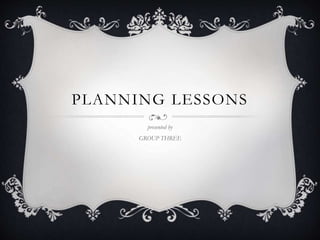
Planning lessons
- 1. PLANNING LESSONS presented by GROUP THREE
- 3. A teacher's purpose is not to create students in his own image, but to develop students who can create their own image.
- 4. OBJECTIVES: • Enumerate the importance of lesson planning. • Formulate specific behavioral aims using keywords from Bloom’s taxonomy of educational objectives. • Write an excellent motivation to be applied in microteaching. • Compose a semi-detailed lesson plan for field study courses .
- 5. Definition of Lesson Plan • A detailed description of the individual lessons that a teacher plans to teach on a given day. • A lesson plan is developed by a teacher to guide instruction throughout the day. It is a method of planning and preparation. • A lesson plan traditionally includes the name of the lesson, the date of the lesson, the objective the lesson focuses on, the materials that will be used, and a summary of all the activities that will be used. • Lesson plans are a terrific set of guidelines for substitute teachers.
- 6. Importance of Lesson Plan
- 7. It offers optimum results in terms of objectives, activities, and methods. It serves as a guide to an apprentice teacher. It helps in organization of lessons. It is useful for the teacher to develop foresight which can contribute to teaching and can stimulate him/her to become more creative. It prevents waste of time, haphazard teaching, and/or unorganized activities.
- 8. It makes the teacher stick to and not deviate from the main topic. It gives sense of security, especially to the beginning teacher who feels nervous and tense. It ensures good instruction and prepares the teacher for an effective teaching. It serves as a ,means of supervising the teacher’s competency and effectiveness, and determines the teacher’s mastery of the subject matter and teaching preparedness. It can be used by a substitute teacher who will frame future lessons.
- 9. “PARTS OF A LESSON PLAN” Mr. Joshua Abel De Guzman
- 10. DATE
- 11. OBJECTIVE •General Objectives -Know, understand, and learn. •Specific Objectives -Behavioral or instructional goals for a particular topic.
- 12. OBJECTIVE
- 13. SUBJECT MATTER
- 14. MATERIALS NEEDED
- 16. GENERALIZATION OF THE LESSON
- 17. EVALUATION
- 18. ASSIGNMENT OR AGREEMENT Ito ay hindi dapat ginagawa sa school na karaniwang binibigay ng Teacher bago mag-dismissed. Ano ito?
- 19. Lesson Plan template LESSON PLAN FORMAT Teacher: ____________________________ Date: ____________________________ Class: ____________________________ Subject Area: Unit Goal(s): (Tennessee Frameworks) Behavioral Objective(s): ( Include Bloom’s taxonomy level) Set: Procedures: Closure: Remedial/Enrichment Activities: Evaluation: Materials and Media: Webliography: Deaf Role Models:
- 20. Class: In this section you need to identify the grade level of students Example: Third Grade You also need to write a short description of your population Example: Class of 5 deaf students
- 21. Subject Area: In this section you will write the subject area Examples: Math Language Arts Theme and subject area Science Social Studies
- 22. Unit Goal(s): In this section you will write the broader, more global overall goals. You will use the curriculum goals OR state frameworks goals (http://www.state.tn.us/education/ci/standards/index.php) If you use the state framework goals…list the numbers also Example:Content Standard: 1.0 The student will develop the reading and listening skills necessary for word recognition, comprehension, interpretation, analysis, evaluation, and appreciation of print and non-print text.
- 23. Behavioral Objective(s): Write the behavioral objectives for this lesson Be sure to include a condition, performance and criteria List the level of Bloom’s Taxonomy for each objective Be sure to have at least 2 objectives
- 24. Set: Write a description of the set you plan to use to introduce the lesson This should be something that will “grab” their attention as well as something that will show the relevance of the lesson to those students Discuss examples
- 25. Procedures: In this section you will write all the steps of what you plan to do Include the steps for the teacher activities Include the steps for the students activities The more detail you have…the smoother and more effective the lesson will be.
- 26. Closure: In this section of the lesson you will include an activity that will summarize the information presented to the students This may be a concluding activity to the lesson such as students presenting what they created or completed in class. This may be questioning by the teacher about the objectives of the lesson
- 27. Evaluation: This is an explanation of how you will evaluate your students’ performance on the objectives You may use a rubric to evaluate the objectives You may choose to evaluate the results of the closure activity. The evaluation MUST be related to your behavioral objectives.
- 28. Remedial/Enrichment Activities: Remedial: These are ways that you will adapt the lesson for students in your class who need additional support and modifications Examples might be some visual that others do not need or fewer problems, etc. Discuss examples
- 29. Enrichment Activities: These are modifications that you would add for students who complete the work early or who need more challenging work Discuss examples
- 30. Materials and Media: In this section you need to list all the materials and/or media you will need to implement this lesson Examples: projector PowerPoint Presentation Lesson Plan sheets
- 31. Webliography: This is a list of any websites that you used to: Find activities Find additional information to include in the lesson Student sites for additional practice Frameworks URL
- 33. An environment of an active people An atmosphere that tolerates ambiguity An emphasis on the uniqueness of every learners personalities A none threatening psychological climate
- 34. An experience motivated by the learners Discovery of personal meaning & Relevance Sometimes a painful process A collaborative and cooperative process Both unique & individual Both emotional & intellectual process An evolutionary process
- 35. END
- 36. presented by GROUP 3
